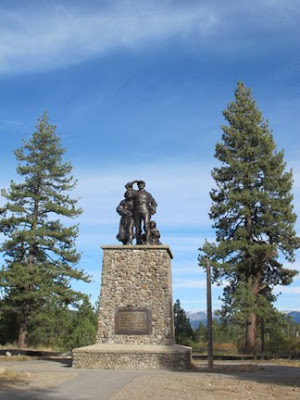Jill's Journal: It was in the fall and winter of 1844-45 the first wagon train successfully crossed the Sierra Nevada mountain range. They camped at what would eventually be named Donner Lake (shown above), only to decide the majority of their wagons and provisions would not be able to reach the summit. Much was left behind (along with three men), while the balance traveled on to Sutter’s Fort in what is now modern-day Sacramento. It was four months before the last of the group was able to trickle into Sutter’s Fort.
That party may have been the first wagon train to successfully cross the Sierras, but it was two years later (in 1846-47) what would become the most famous, or infamous, of the wagon trains attempted the same crossing. Known today as the Donner Party, the group of 89 veered off the main trail in Wyoming on a presumed shortcut. A map in a guidebook entitled “An Emigrant’s Guide to Oregon and California” appeared to cut 200 miles off the journey. Instead, it cost them six fateful weeks.
Back on the main trail, the Donner Party found themselves trapped in October of 1846 at Donner Lake in heavy snow and an early winter. Five foot snow drifts left them unable to go forward or backward. Repeated escape attempts proved fruitless. It has been well documented how their provisions were quickly depleted, their oxen and livestock were butchered, and the survivors turned to the gruesome desperation of cannibalism. Only forty-seven of the original 89 survived. Many were women and children.
The face of this rock was used as the north end (and the fireplace) for one of the several rough cabins built for shelter by members of the Donner Party. In June of 1847, a General passing through buried the bodies he found in the area under the floor in the middle of the cabin, or roughly under where the trail passes now.
Dedicated to all the brave souls who made the grueling journey across the Sierras to California in the 1840s, the Pioneer Monument is near the Donner campsite. The base of the monument measures 22 feet high, the same height of the snow during that terrible winter of 1846-47. It was unveiled in 1918 in a ceremony that included Donner Party survivors. The whole area is a National Historic Landmark.
The Emigrant Trail Museum at Donner Memorial State Park is small and dated, but it does have some wonderful artifacts from the Donner Party. It also features Donner items found in an archeological dig on the site. A new museum is being built which promises to really showcase the history of the area.
We weren’t really dressed for the snow, but that doesn’t thwart kids, does it? Erika got the most out of the area as we’d picked up a book at Sutter’s Fort called “Patty Reed’s Doll” and she’d quickly devoured it. Eight-year-old Patty Reed was one of the Donner Party’s survivors. When they’d had to leave their belongings behind (long before reaching the Sierras), little Patty Reed snuck her tiny, approximately four-inches-tall, wooden doll into her dress pocket. The doll provided her with comfort and companionship during the bleak winter. Erika so enjoyed her story.
Madelyn flashed her toothless grin at gathering up snow in an empty water bottle. She wanted to do “an experiment” to see if it would melt. It most certainly did. :) If only the Donner Party had been so lucky.







No comments:
Post a Comment